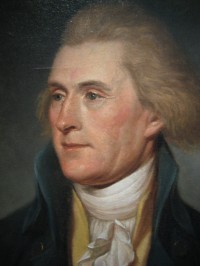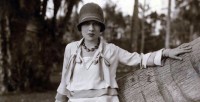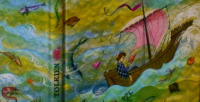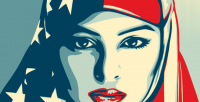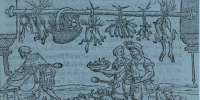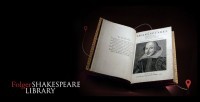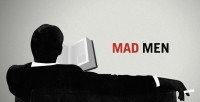It's common knowledge that Thomas Jefferson penned the Declaration of Independence, but did you realize he was also the first American to record a recipe for ice cream? Jefferson's recipe was for vanilla ice cream and he, sadly, did not name it Declaration of Deliciousness (which would be a perfect name if Ben & Jerry's decided to make a tribute flavor!). Precursors to ice cream, often ice mixed with fruits or juices, appeared in ancient Greek, Chinese, and Persian cultures. It's believed that the first milk based icy treat and the earliest device to make a 'ice cream' appeared in China during the Tang Dynasty (618-907 AD). These frozen iced-based drinks gained popularity in Europe, and in the 17th century it became popular to turn these drinks into frozen desserts. Italians added sugar to the concoction and sorbet (then called sorbetto) was born. A Neapolitan, Antonio Latino, is credited with creating the first milk-based sorbet, the earliest form of our modern day ice cream. The French also were experimenting with their own form of ice cream called fromage, a misleading designation since there recipe did not contain cheese, and by the 18th century it had become a popular treat. Here's where Jefferson enters the picture. Ice cream is thought to have come to America with settlers in the early 18th century, so Jefferson may have encountered the dessert in the colonies, but there is no doubt that he enjoyed it during the five years he spent in France (1784-1789). Four ice molds... [more Thomas Jefferson’s Ice Cream Recipe]
Et Cetera
Pioneering screenwriter Anita Loos was born on April 26, 1889. After learning her trade acting and writing one-act plays for her father's somewhat-disreputable theater troupe, Loos began submitting unsolicited scripts to film companies. D.W. Griffith directed The New York Hat, a film based on her screenplay, starring Mary Pickford and Lionel Barrymore in 1912. In 1915 Loos became the first “staff writer” for a film production company, when she signed on with Griffith's studio. She wrote hundreds of scripts during the silent era of cinema, most of which went unproduced, but the films that were made were noted for their wit and humor — all the more remarkable for being silent! Her collaboration with director (and future husband John Emerson) began by working on several romantic comedies which made Douglas Fairbanks a star. In later years, many of the scripts that carried both of their names would be primarily Loos' work, however. It was often convenient, in the Hollywood system of the 1930s and '40s, to have a male co-writer, as some directors were unwilling or uncomfortable discussing the script with a woman. During a period of infatuation with H.L. Mencken (who apparantly had a thing for blondes) Loos wrote a series of stories about a chorus girl on the lookout for a rich paramour, the Lorelei Lee stories. These were such a hit for Harper's Bazaar that they soon became a novel, Gentlemen Prefer Blondes (1925) which became a runaway bestseller. A broadway adaptation foll... [more Anita Loos: Hollywood Pioneer]
Get your new year off to a good start by examining a few highlights from around the abaa.org website or found within the pages of our members' latest rare book catalogs. Cassic orange Penguins are always eye-catching. This one is was also an influential part of early science fiction. The Quatermass Experiment: A Play for Television in Six Parts by Nigel Kneale Description: : Penguin Books, .. Small octavo, printed wrappers. First edition. Prints Kneale's revised script for the first of the three BBC Quatermass serials aired in 1953, 1955 and 1958/1959 respectively. Includes film stills. "Effective melodrama and social satire for its time." - Anatomy of Wonder (1987) 3-231. "Excellent scripts." - Pringle, The Ultimate Guide to Science Fiction, second edition (1995), p. 294. "With hindsight, there is a clear pattern in Kneale's work in which ordinary people are seen as stupid and ignorant, and ready prey for the supernatural or science-fictional forces that will almost inevitably attempt to control them. There is a seigneurial, Edwardian element in this, a recoiling from the vulgar. This is a point worth belaboring, because Kneale was certainly a much better than average scriptwriter -- the Quatermass series especially is exemplary -- and his scripts were, paradoxically, very influential on SF, at least at the Gothic and irrational margin of the genre where SF meets fantasy, particularly among film and television producers, who never expect SF to make sense anyway." - SFE (onli... [more Books of the Week]
The idea of the beach read encapsulates how most people seem to regard reading in the 21st century: a solitary activity, preferably performed in a comfortable place, and accompanied by an alcoholic beverage. Modern readers display their bona fides on Instagram with stylish photos of reading nooks and “still life”-type imagery featuring books (or, I'm sad to note, Kindles and iPads) and beverages of choice (most often, cups of coffee or glasses of wine). There's even a curious trend of people posting pictures of themselves reading alone in bars, sending a slightly odd mixed-message: are they in search of company, or advertising the fact that they are above the need for company? Whatever the motivation for sharing these photos, they all reflect the dominant view of reading as a virtuous, solitary, and slightly hedonistic act. However, this was not always the case. Rare bookseller Ernest Hilbert (of Bauman Rare Books) recently reviewed The Social Life of Books: Reading Together in the 18th Century Home by Abigail Williams for the Washington Post. Williams explores the “heyday of communal reading,” 18th-Century England, and details how rising literacy gave birth to a trend for reading aloud as a social activity. In fact, social commentators like Joseph Addison campaigned that reading should move from the private to the public sphere to improve education. Other factors like poor light and failing eyesight created a need for books for be read aloud — witness Jo reading to... [more Reading: Solitary or Social?]
Millions of people who have joined, or watched, the recent protests across the country, beginning with the March for Women, have been struck by the diversity of signs in the crowd. Princess Leia as political crusader, puns riffing on the latest social media meme, diagrams of ovaries, statements of solidarity with Muslim refugees – all have been present, in endless variety. Surprisingly, perhaps, it was not always so. Many libraries and museums collect historical protest signs, and the study of these signs reveals many changes over the years — not only in the issues directly addressed by the signs themselves, but in evolving styles of communication, and the influence of the broader cultural environment. It might seem surprising that some libraries, committed to the preservation of literature and the written word, also collect protest signs. If the effort of prose is to persuade, then such signs (as well as pin-back buttons and bumper stickers) are the epitome of concise communication. The simplest signs simply state an opinion, while others make more of an effort to change the reader's mind, to use a turn of phrase to catch attention (and converts). And some signs – often those that reveal the most about their society – make more complex use of text and image, playing the part of a hand-held, sturdier version of a propaganda poster. We could trace the origins of hand-carried political signs to the Roman era if not earlier, but for the purposes of this blog we will exam... [more Protest Signs: Barometers of Social Change]
ABAA member Tom Nealon (Pazzo Books) specializes in early printed books and cookbooks, and has drawn on his knowledge of these areas to write a book on the history of food and its vital influence on the course of human history, Food Fights and Culture Wars: A Secret History of Taste. In this brief introduction, Tom Nealon explains what drew him to early cookbooks and food is connected with arcane secrets and the spread of the Enlightenment. As fond as I am of eating, from the beginning it was the lies and artifice of food that grabbed me. About ten years ago, I had the idea to try to cook every food mentioned in Geoffrey Chaucer's The Canterbury Tales (c. 1390). I think it arose from my interest in the scurrilous cook Roger, who would drain gravy out of pies to sell in the lucrative second-hand gravy market, but also that I had ended a run of bad restaurant jobs to open my used bookshop in Boston, Massachusetts, and I wanted to splice these two lives together. One of the first dishes that I cooked in preparation for my project was a thirteenth-century recipe for chicken, that was first taken off the bone, the bone cleaned and boiled, and, finally, the chicken rewrapped around the bone and fried in place to achieve chicken disguised to look like chicken. I've long had a dilettante's interest in the food of the Late Middle Ages – that is, from around 1300 to 1500. The food of these times is so foreign to our own: turtledoves, mutton, flagons of mead, and pork fat, which seems... [more Food Fights & Culture Wars]
Some of the most-expensive books in the world are going on tour. The Folger Shakespeare Library is sending several First Folios to partner institutions around the country -- one in each state -- so people can view the famous books upclose and personal. WIlliam Shakespeare's First Folio is a remarkable thing. Compiled just seven years after the great man died, the Folio (so-called because of how the book was printed — “When two leaves (four pages when printed on both sides) were printed on a sheet so that it could be folded once, collated with other folded sheets and bound, the format of the volume was a folio." — from the ABAA Glossary of Book Terms) was created by two actors who knew Shakespeare and would have had access to original drafts (referred to be the delicious term “foul papers” as they would have presumably been covered in handwritten edits, notes, and all manner of marginalia, rather than pristine, printed texts), transcripts prepared for the actors, or official prompt books from the original productions. If not for this book, those various copies would have likely been scattered and lost, and more of Shakespeare's plays could have been lost to time. For such a famous and influential book, there are few copies left in existence. Perhaps 750 copies were printed in 1623. Only 233 are known to exist today. The Folger Shakespeare Library in Washington, DC, is home to an unrivaled collection of Shakespeariana, including 82 of the surviving First Folios. Comed... [more First Folio on Tour]
Let's start with all the other book news that's been overshadowed by the publication of the "new" Harper Lee book this week. Charles Dickens' Notes Solve Mystery of Unidentified Victorian Authors Hailed as a discovery that could "solve some of the biggest mysteries of Victorian literature," the news that a book collector has found Charles Dickens personal copies of his magazine "All the Year Round" was revealed over the weekend. The magazine famously published anonymous pieces -- providing academics with decades of fun and publication trying to identify the true authors -- but Dickens' personal copies contain annotations that reveal the authorship of each article. Among the work identified are new pieces by Lewis Carroll, Elizabeth Gaskell, Wilkie Collins, and Eliza Linton. Read more... ALL THE YEAR ROUND. A Weekly Journal. No. 83. Saturday, November 24, 1860. By Charles Dickens (Editor.) London:. 1860.. 8vo. 9-1/2" x 6-1/4". 1st printing. Pp (145) - 168. Text double column. Advert for 'Great Expectations' to p. 168.. Printed self wrappers, nested (not sewn). "Price 2d". Age-toning. A VG+ copy. (Offered by Tavistock Books) Malala Yousafzai Champions Books Nobel Peace Prize-winner Malala Yousafzai called on world leaders to emphasize education over conflict in a recent speech. “I am here as the voice of children, as the voice of over 60 million girls who have been stopped from getting their education,” Yousafzai said. Being young and tech savvy, Yousafzai launched the hash... [more Rare Book News: July 2015]
SUNDAY: You could easily be excused for thinking that in the seven-month-long hiatus between major American book fairs (April in New York, November in Boston) there would be a sort of doldrums in which booksellers settle down and catalogue away, alone in their lairs (or maybe even just go fishing). Not so. Each summer beginning in June an institution called, simply, "Rare Book School," hosts a series of week-long sessions on the campus of the University of Virginia in Charlottesville. Rare Book School (from here on in I'll just call it "RBS") is dedicated to, well -- the study of rare books. It's death-by-chocolate for serious book addicts, attracting dealers, collectors, librarians, researchers, academics, students -- really anyone with a deep and abiding interest in everything books. 2015's season began on the 7th of June, on a Sunday evening, with a welcoming lecture by the dynamic director of RBS, Michael Suarez. His topic was "The Library (capital L) as both community and as cure for the soul." It was a moving and inspiring talk, and the assembled crowd drank it up, then dispersed to talk of bookish things with their fellow students (there may have also been either drinking or dining involved), before falling into bed, ready to dive into book heaven bright and early Monday morning. MONDAY: 8 am. The RBS doors open, and a lavish spread of bagels and cream cheese, yogurt and granola and fresh local fruit, and an assortment of juices, teas, and coffee awaits. I recognize se... [more Rare Book School Journal]
Among the many reasons we'll be sorry to see the end of Mad Men is the bravura way the writers have woven literary references into the show. Characters have been seen reading books that were popular at the time as well as obscure volumes that explored themes they would have found very meaningful at the time. We went back through the DVD box-sets, and noted the major titles featured and a few of the more interesting minor ones. Atlas Shrugged by Ayn Rand Way back in season one, Rand's objectivism was established as an influence on Don's character: driven, selfish, and ambitious. The book was recommended to Don by Bert Cooper, and from Don's confident and egotistical pitch to a client in episode eight, he appears to have taken it to heart. The Sound and the Fury by William Faulkner After bedding Joy in season two, Don sees her reading The Sound and the Fury. He asks if it's good, and she answers that she enjoyed their romp, but the book is only OK. The allusion to this chronicle of a dysfunctional old Southern family dealing with financial and social ruin is obvious. The Agony and the Ecstacy by Irving Stone Used as a rather heavy religious metaphor to underline how Peggy is changing her life in the second season. The History of the Decline and Fall of the Roman Empire by Edward Gibbon While Betty's father lives with the Drapers after his dementia becomes acute, Sally reads this from the Decline and Fall every night. The repeated allegory is a little heavy handed. The Spy Who C... [more The Books of Mad Men]


